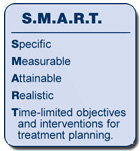|

S.M.A.R.T. Treatment Planning
 A
look at how the S.M.A.R.T.
Treatment Planning products were created illustrates
the close cooperation required by the Blending Initiative.
The initiative brings together researchers supported
by the National Institute on Drug Abuse (NIDA) and trainers
from SAMHSA’s Addiction Technology Transfer Centers
(ATTCs) to get research findings into the hands of practitioners. A
look at how the S.M.A.R.T.
Treatment Planning products were created illustrates
the close cooperation required by the Blending Initiative.
The initiative brings together researchers supported
by the National Institute on Drug Abuse (NIDA) and trainers
from SAMHSA’s Addiction Technology Transfer Centers
(ATTCs) to get research findings into the hands of practitioners.
With NIDA support, researcher A. Thomas McLellan, Ph.D.,
founder and Chief Executive Officer of the Treatment
Research Institute (TRI) in Philadelphia, PA, and his
colleagues developed the Addiction Severity Index (ASI)
in 1980. The ASI helps addiction counselors systematically
collect information about seven areas of patients’
lives, including alcohol and drug use, medical and psychiatric
problems, employment, legal issues, and family and social
relationships.
In addition to giving clinicians a framework for gathering
information about all aspects of a client’s life,
the ASI also provides objective data that both clinicians
and researchers can readily understand.
“The substance abuse field has never had something
like a blood pressure rating, where you could say, ‘This
client is 130 over 80,’ ” explained Deni
Carise, Ph.D., TRI’s Director of Treatment Systems
Research. “We basically had descriptive things
like, ‘This person drinks far too much,’
or ‘This person drinks a lot,’ or ‘This
person’s a heavy drinker.’ You can’t
tell which person drinks more than the others.”
By now, most clinicians use the ASI to assess substance
use treatment disorders. Yet these professionals don’t
always make the most of the data generated by the tool,
viewing it merely as required paperwork. “People
often do the assessment, throw it in the chart, and close
the file,” said Dr. Carise.
The ASI Blending Team hopes to make the assessment tool
more broadly accessible and understandable, so that it
can be used to maximum advantage. The team consists of
Dr. McLellan, Dr. Carise, and Meghan Love on the science
side and three ATTC representatives on the technology-transfer
side.
Aimed at addiction counselors and their supervisors,
the S.M.A.R.T. Treatment Planning curriculum explains
how to use the ASI for clinical purposes, and in particular,
treatment planning. “The curriculum walks people
through the process of collecting information about patients’
problems and then using that information as the building
blocks of a treatment plan,” explained ASI Blending
Team Chair Richard T. Spence, Ph.D., Director of the
Gulf Coast ATTC in Austin, TX.
After developing and piloting the curriculum, the blending
team conducted a “training of trainers” session.
The ATTCs are now developing a cadre of trainers who
can offer the training, said Dr. Spence, noting that
the ATTC national office maintains a list of available
trainers around the country.
The curriculum for S.M.A.R.T.
Treatment Planning: Utilizing the Addiction Severity
Index (ASI): Making Required Data Collection Useful
can be accessed at www.nattc.org/aboutUs/blendingInitiative/
blendingteams.htm#asi. 
See Also—Blending
Initiative
« Initiative Blends Research &
Practice
« Blending Tools
S.M.A.R.T. Companion Products »
See Also—Next Article »
Back to Top
|




